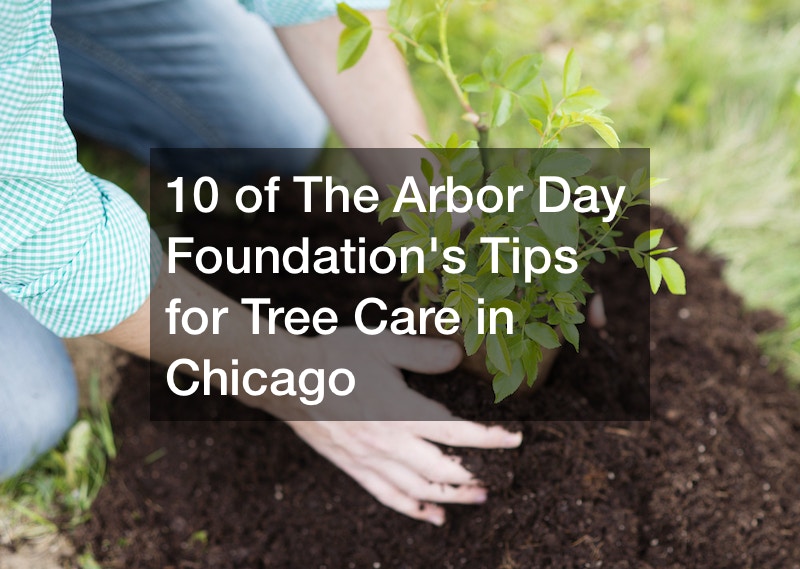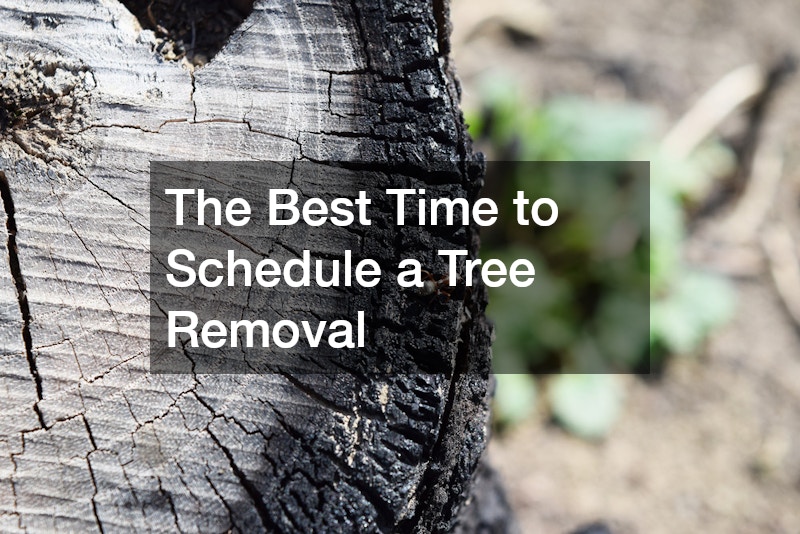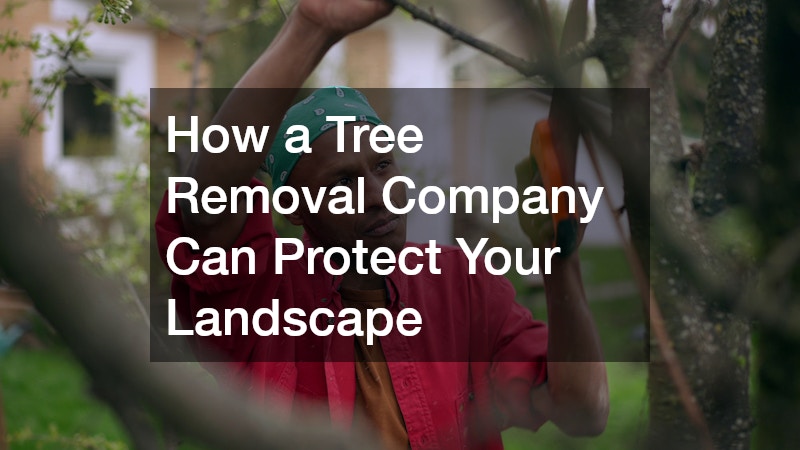The Arbor Day Foundation is a valuable resource for growing and caring for trees. Every region has different requirements for caring for trees. These 10 Arbor Day Foundation tips are specifically for caring for trees in the Chicago area. However, many of the Arbor Day Foundation’s tips here can be applied to tree care in other regions. Some of the tips are general, while others are specific. Check out these 10 Arbor Day Foundation tips to keep your trees healthy.
1. Know When to Remove a Tree
The first of the Arbor Day Foundation’s tips may seem off-brand. The Arbor Day Foundation is well known for its Plant Trees campaigns, so initially, it may seem a little odd that they advocate for removing trees as well. Keep reading, and this tip will make more sense.
Regarding tree care, one of the most critical aspects is understanding when it’s necessary to remove a tree. Local tree removal services are often called upon to assess and safely remove trees that pose risks or have reached the end of their natural life. Trees that are diseased, damaged, or structurally compromised can become hazardous. If a tree poses a risk to people, property, or utilities, removal may be the safest option.
Removing diseased or infested trees can promote good health in the surrounding trees. Trees with declining health, where more than 50% of the canopy is affected, may not recover and should be removed to protect the landscape. A local tree expert can help you to make informed decisions about tree removal. Ultimately, sacrificing one tree to save money and to prevent injury or property damage is necessary.
2. Don’t Risk DIY Tree Removal
One of the key Arbor Day Foundation’s tips for tree care is not to try to remove a tree on your own. Tree removal is a specialty skill set. An emergency tree service can help if you have a dangerous tree on your property that needs to be immediately removed. There is a serious risk involved with removing trees.
The risk of DIY tree removal includes personal injury risk, property damage risk, and risk to the surrounding trees and landscape. Additionally, you may remove a tree that doesn’t need to be removed. It takes an expert eye to determine which trees need to be removed and which trees are not a threat. It’s best to leave tree removal up to professionals who are highly skilled in the removal process.
Unhealthy trees, precariously hanging limbs, and the equipment required to remove a tree all pose a physical danger. Of course, the proper equipment for tree removal is also an expense that most homeowners don’t want to incur. Professionals come fully outfitted with the necessary equipment, including personal safety equipment, to ensure that the tree is removed safely.

3. How to Select a Healthy Tree for Planting
The Arbor Day Foundation’s tips for choosing healthy trees in the Chicago area for planting are essential to ensure that you choose trees that will thrive on your property. Local tree services are also a great resource for choosing healthy trees native to the Chicago region. Tree services can help with the selection, planting, and maintenance of your new trees.
There are several areas of consideration regarding tree health. Intact bark is the suitable color, leaf health, or bud health, and the stature of the tree. The trunk should be free from wounds, cracks, or signs of disease. It would be best if you chose native trees to ensure hardiness for the Chicago area climate. Examine the tree’s root system. Healthy roots should be well-distributed, not circling the root ball.
Proper planting techniques are essential for a tree’s success. Understanding the soil conditions in your planting site is essential. Conduct soil tests to determine its composition and pH levels. Starting out with a healthy tree is step one in the tree planting process.
4. How to Choose a Great Tree Service in Chicago
Arbor Day Foundation’s tips are not mutually exclusive to DIY tree care and planting. This tip can help you locate a trusted local tree removal contractor when you need a tree removed and find a local tree service that provides comprehensive tree care services. Selecting a reputable provider of tree services in the Chicago area requires a small amount of research.
The first thing you want to check for is licensure and insurance. You need to choose a provider that can verify they have the proper insurance coverage. A reputable business will have insurance to protect their workers and to protect your property from any damage or liability. Certification from organizations like the International Society of Arboriculture (ISA) indicates a commitment to professionalism and expertise in tree care.
Experienced tree service providers bring a wealth of knowledge about local tree species and common issues in the Chicago area, and they typically have great online ratings from customers. Check online ratings to gauge the satisfaction of previous customers. Past performance can be an indicator of future performance.

5. How to Plant a Tree Properly
Most people choose a local tree service company to manage planting their trees. It makes the most sense to let the experts handle the task to ensure proper planting. Getting your trees off to the right start is essential to the long-term viability and health of the tree. However, if you want to DIY tree planting the Arbor Day Foundation’s tips should help.
Gently remove the tree from its container or burlap, being cautious not to damage the roots. If the tree is in a container, gently loosen and spread the roots before planting. After planting, water the tree deeply to help settle the soil and remove air pockets around the roots. Keep the soil consistently moist during the first few years of growth, especially during dry spells.
Apply a layer of organic mulch around the base of the tree, leaving a gap around the trunk to prevent moisture retention against the bark. Mulch helps retain soil moisture, regulate temperature, and suppress weeds. Prune very sparingly during the first few years of growth.
6. How to Mulch Around Trees
According to the Arbor Foundation’s tips mulch is great for trees, but there is a balance. You don’t want to go overboard with the mulch, and you don’t’ want to use too much. Local tree companies are experts in adding mulch around trees.
There are a few things to keep in mind when you are selecting and spreading mulch. Organic options are the best option. Clean dry, debris free mulch is best for trees. Adding too much mulch can have the opposite effect than what you are looking for. An overabundance of mulch can keep moisture from trickling down to the root system of the tree. Additionally, too much mulch can invite pests, fungus growth and mold and mildew.
Here are a few good rules of thumb to follow when applying mulch to your trees. The mulch layer should be about 2 to 4 inches (5-10 cm) deep. Avoid piling mulch against the tree trunk; leave a gap to prevent moisture from accumulating against the bark. Use a garden rake to spread the mulch evenly across the designated area. This helps in achieving a consistent depth and appearance.

7. Tree Watering Best Practices
According to the Arbor Day Foundation’s tips for tree care in Chicago, too much of a good thing can be a bad thing, even when it comes to the amount of water you provide for your trees. Tree care companies are a safe option if you are concerned about the proper amount of water your trees need. You not only have to consider how much water you provide, but how you water, and when you water trees.
Over time, the amount of water you provide should decrease. Nature provides everything a tree needs, except in drought conditions. It is best to water deeply instead of more frequently. Deep watering using soaker hoses is strongly suggested.
You should water in the mornings and water around the drip line of the tree. The drip line is the area slighting away from the trunk where the roots are located. It’s essential that you water your trees correctly, especially in the early years.
8. How Trees Impact Your Home’s Curb Appeal
Healthy trees that are planted in strategic locations can have a positive impact on the curb appeal of your home. Local landscape lighting companies can enhance the look of your trees and further improve the curb appeal of your home. Trees are an essential part of landscaping for any home.
Well-placed trees can frame your home, providing a natural focal point and enhancing the architectural features. They can create a sense of balance and harmony, making your property visually pleasing. Shade-providing trees, such as oaks and maples, can create comfortable outdoor spaces.
Trees contribute to improved air quality, reduce energy consumption, and mitigate stormwater runoff, showcasing your commitment to environmental stewardship. Trees along the street or driveway create an inviting atmosphere for visitors and passersby. A tree-lined street is often associated with a welcoming and charming neighborhood.

9. When and How to Prune Trees
The Arbor Foundation’s tips on how to prune trees. Of course, hiring landscapers is the best option to ensure that your trees are pruned correctly. It’s essential that you use the right tools and understand what each individual tree needs. It is a learning process to learn how to prune trees the correct way.
Different tree species have specific growth patterns and pruning requirements. Familiarize yourself with the type of tree you are dealing with before starting the pruning process. Begin by identifying and removing dead, dying, or diseased branches. These are a priority as they can harm the tree’s overall health. Identify the goals of your pruning activities.
Begin by identifying and removing dead, dying, or diseased branches. These are a priority as they can harm the tree’s overall health. Tree pruning is an art and a specialized skill set. Taking the time to learn more about the proper way to prune trees will prevent injuries to your trees.
10. When and How to Rake Fallen Leaves
Autumn in Chicago is a beautiful time of year. However, there is a lot of leaf litter to deal with. The Arbor Day Foundation’s tips for how to properly rake up leaf litter can help. Of course, if you don’t have the time to manage fall cleanup on your own, you can always choose to hire lawn maintenance landscaping contractor to manage it for you.
Raking can be a laborious job. It can put a strain on your back and other body parts. Having the right equipment on hand is essential to making the process easier and safer. At minimum you will need a good pair of work gloves, eye protection, and a rake designed specifically for raking leaves.
Ideally, you should rake leaves late in the fall when most of the leaves have fallen from the trees. You could do the raking in small increments, but it can be daunting to have to rake every weekend. Working in the same direction will ensure that you can clear section by section. Ensure that you have a leaf disposal plan in mind.
The Arbor Day Foundation has a wealth of information and resources available to help you learn more about trees, the benefits of trees, and how to care for trees. They also are a great source for purchasing trees and shrubs. Most people enjoy the trees on their property with a little expert help from local tree companies. If you want to learn more, start at the Arbor Day Foundation and connect with a local provider who can complement the information you gain from the Arbor Day Foundation.




